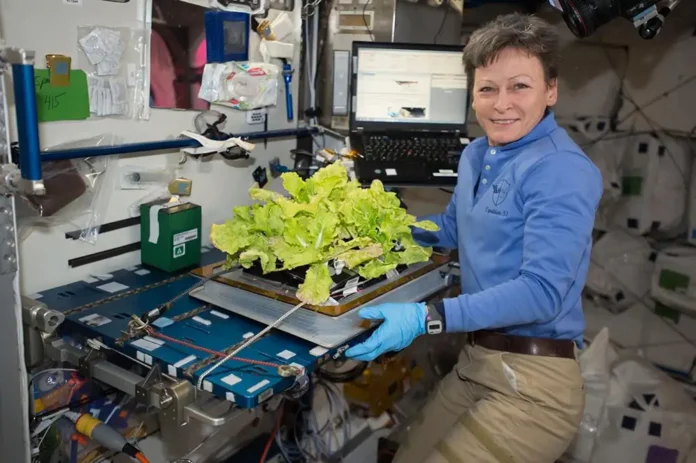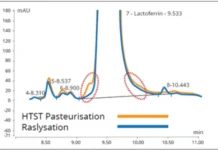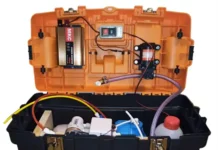By Keith Warriner, Lara Jane Warriner and Mahdiyeh Hasani, CPHAZ, Department of Food Science, University of Guelph; kwarrine@uoguelph.ca
The launch of the SpaceX Starship represented a tentative step towards establishing colonies on the Moon and then to Mars. Although we are unlikely to be enjoying a Caesar salad while watching Earthrise anytime soon, there are groups challenging the problem of how to grow crops in space. Within the University of Guelph, the Growth Options for Outer Space Environments (GOOSE) group has developed self-contained systems to provide the optimal light wavelength, nutrition and atmosphere to grow fruit and vegetables in space. However, challenges remain – including preventing plant and human pathogens from entering the controlled environment and extending shelf life. Within the Space environment, anything required needs to be transported, and no chemical residues can be left given everything would undergo recycling. Moreover, such a system needs to be sustainable with low energy requirements.
Given the system requirements, it is not unexpected that UV-based technologies will play a significant role in Controlled Environment Agriculture (CEA) in the stars and closer to Earth. In the following, the application of UV lights will be compared with UV systems based on the hydroxyl-radical process. The latter relates to aqueous or gas-phase treatments based on the generation of hydroxyl-radicals from the UVC mediated degradation of hydrogen peroxide and/or ozone.
Controlled Environmental Agriculture is the Future
Controlled Environmental Agriculture and vertical farming are used interchangeably to describe crops cultivated within a controlled environment. The CEA sector is big – literally and figuratively growing, with a current market value of $4 billion and forecast to increase by 25% each year from now until the end of the decade. 5 One can see the attraction: Not only can crops be grown in inhospitable environments, but it also provides shelf-sufficiency and diversification of supplies. For the colonists in space, CEA also will provide a taste of home and a change from the algae-dominated diet they probably have to eat to survive.
CEA also is perceived as being safer, when compared to open-field cultivation, given that is enclosed and thereby protected from potential contamination sources (water, air, insects, etc.). Yet, contaminants (for example, human and plant) pathogens can be introduced on the CEA inputs (seeds, water, growth substrate, etc.), and then survive and flourish to a greater extent when compared to field environments. 10, 12 Therefore, there is a need to ensure the inputs into CEA are free of contamination, limit the spread during production and apply a post-harvest treatment to remove any residual hazards, along with extending shelf life.
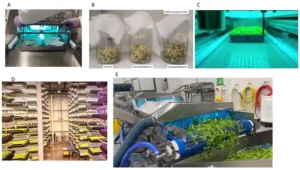 Seed treatments
Seed treatments
Pathogens (human and plant) can be carried via the seeds; hence, the seeds require disinfection prior to planting. UVC has been applied to seed disinfection, although the dose requirements are in the order of kJ/cm2 to overcome the protective niches on the seed coats. 9 A benefit of the high UV doses is to stimulate the germination of seeds by eroding the seed coat. 3 Yet, to save energy and enhance the efficacy of seed disinfection, it is possible to apply a hydroxyl-radical based process 2 (Figure 1a). Here, the hydroxyl-radicals can penetrate the protective niches and enhance the germination of seeds. A similar process is soaking seeds in Activated Water (Figure 1b) that is based on running a hydrogen peroxide solution with Fe(III) catalyst through a UVC reactor. 11 The reaction with UVC initiates a Harber-Weiss-like reaction to propagate antimicrobial hydroxyl-radicals. The process supports pathogen reduction and enhances seed germination rates and sprout yield.
Growth substrate
Within CEA, plants can be cultivated on peat-based substrates, in hydroponic solution or on infused growth-substrates, such as rockwool. Although hydroponics would be considered the preferred option, it has been shown that bacteria such as Escherichia coli can persist longer and colonize plants to a greater extent under hydroponics vs. soil. 4, 12 Regardless of which growth medium is used, there is a need to apply a decontamination method that reduces microbial loading without negatively affecting plant development. Ozone has been proposed, along with peracetic acid, although both can cause root-burn. UV-based methods are an alternative but require overcoming the low UV-transmission caused by phenolics derived from decaying plant material. Therefore, UV reactors require to be innovative through inclusion of static-mixer elements, thin-film or turbulent reactors. Key is to ensure that a minimum UVC dose is applied to prevent the generation of furans, along with other photoproducts, that negatively effect plant development. There also is the potential to inactivate beneficial rhizobacter required for plant health. 15
It is possible to perform an Advanced Oxidation Process reaction that overcomes the limitation caused by low UV-transmission, although it still would have a negative effect on beneficial microbes. 8 Decontamination of peat-based substrates is more challenging given UV had no penetration. Yet, Activated Water has been demonstrated (results yet to be published) to inactivate pathogens within the substrate and then dissipate.
Air disinfection
Air circulation is an essential feature of CEA to prevent accumulation of carbon dioxide and maintain homogenous temperature. As marijuana growers learnt to their cost, pathogens can be disseminated via the air within the room and extend to other growing areas, depending on the air management system. As identified during the pandemic, Far UV was shown to be effective at air disinfection without requiring the energy requirement of HEPA filters. 6
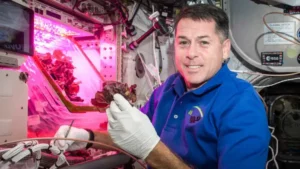
Growing plants
The UV treatment of growing plants is becoming an established method for inducing plant defenses that includes enhancing synthesis of phenolics, such as anthrocyanines. 14 UVB is the most common light source applied, although it requires relatively prolonged exposure times. UVC can induce plant defenses but must be controlled to prevent negative effects on plant development. However, gas-phase hydroxyl radical treatment (Figure 1c) has been shown to combine both the advantages of UVB and UVC in inducing plant defenses and extending shelf life of fruit and vegetables. 14
Post-harvest treatments
In commercial CEA facilities (Figure 1d), post-harvest washing is a traditional treatment to remove debris and decontaminate fresh produce. 7 However, this not only requires significant volumes of water but also is infective. The direct treatment of fresh produce with UV light has been applied, although it requires high doses, along with ensuring each part of the product is illuminated. 1 In contrast, hydroxyl-radical treatment forms a hydroxyl-radical fog that can penetrate into layers of product without requiring high UV doses 13 (Figure 1e).
UV is Lighting up CEA Sector
Colonizing the Moon, Mars and beyond is a romantic vision that is far into the future. However, efforts to develop CEA systems for space are not wasted given the same technologies can enable crops to be grown in the most densely populated areas of cities or the most remote locations. A common feature is to make CEA efficient, autonomous and cost-effective. In this respect, one can envisage that UV-based systems will play an important role as the CEA sector develops.
References
- Jensen, M. H. (2002) Controlled environment agriculture in deserts, tropics and temperate regions – A world review. Proceedings of the International Symposium on Design and Environmental Control of Tropical and Subtropical Greenhouses, 19-25.
- D’Souza, C., H. G. Yuk, G. H. Khoo & W. B. Zhou (2015) Application of Light-Emitting Diodes in Food Production, Postharvest Preservation, and Microbiological Food Safety. Comprehensive Reviews in Food Science and Food Safety, 14, 719-740.
- Hasani, M., F. Wu & K. Warriner (2020) Validation of a vapor-phase advanced oxidation process for inactivating Listeria monocytogenes, its surrogate Lactobacillus fructivorans, and spoilage molds associated with green or red table grapes. Journal of Food Science, 85, 2645-2655.
- Hernandez-Aguilar, C., A. Dominguez-Pacheco, M. P. Tenango, C. Valderrama-Bravo, M. S. Hernandez, A. Cruz-Orea & J. Ordonez-Miranda (2021) Characterization of Bean Seeds, Germination, and Phenolic Compounds of Seedlings by UVC Radiation. Journal of Plant Growth Regulation, 40, 642-655.
- Jablasone, J., K. Warriner & M. Griffiths (2005) Interactions of Escherichia coli O157 : 147, Salmonella typhimurium and Listeria monocytogenes plants cultivated in a gnotobiotic system. International Journal of Food Microbiology, 99.
- Lim, S. & E. R. Blatchley, III (2012) UV Dose-Response Behavior of Air-Exposed Microorganisms. Journal of Environmental Engineering-Asce, 138, 780-785.
- Murray, K., F. Wu, J. Shi, S. Jun Xue & K. Warriner (2017) Challenges in the microbiological food safety of fresh produce: Limitations of post-harvest washing and the need for alternative interventions. Food Quality and Safety, 1, 289-301.
- Nomura, Y., K. Koga, K. Ohnishi, S. Fukahori & T. Fujiwara (2022) Inactivation of plant pathogenic bacterium Ralstonia solanacearum in drainage solution from hydroponic system by a rotating advanced oxidation contactor equipped with TiO2/zeolite composite sheets. Journal of Water Process Engineering, 48.
- Sharma, R. R. & A. Demirci (2003) Inactivation of Escherichia coli O157 : H7 on inoculated alfalfa seeds with pulsed ultraviolet light and response surface modeling. Journal of Food Science, 68, 1448-1453.
- Wang, D., A. Huber, K. Dunfield, K. Murray, F. Wu & K. Warriner (2018) Comparative persistence of Salmonella and Escherichia coli O157:H7 in loam or sandy loam soil amended with bovine or swine manure. Canadian Journal of Microbiology, 64, 979-991.
- Wang, H. R., M. Hasani, F. Wu, R. Prosser, G. B. MacHado & K. Warriner (2022) <p>Hydroxyl-radical activated water for inactivation of Escherichia coli O157: H7, Salmonella and Listeria monocytogenes on germinating mung beans</p>. International Journal of Food Microbiology, 367.
- Warriner, K., F. Ibrahim, M. Dickinson, C. Wright & W. M. Waites (2003) Interaction of Escherichia coli with growing salad spinach plants. Journal of Food Protection, 66, 1790-1797.
- Warriner K, Wang, H & Hasani M. (2020). Gas Phase Advanced Oxidation Process for Surface Disinfection. Paula Davies and Gayathri S. Innovative Food Processing Technologies: A Comprehensive Review. 1: 256-263.
- Warriner K & Hasani M. (2020). UV technology lights the way to plant vaccines: Boosting plant defenses to extend shelf life of fruit and vegetables. 5. UV Solutions.
- Zhang, W. & J. C. Tu (2000) Effect of ultraviolet disinfection of hydroponic solutions on Pythium root rot and non-target bacteria. European Journal of Plant Pathology, 106, 415-421.


